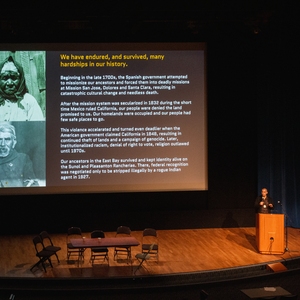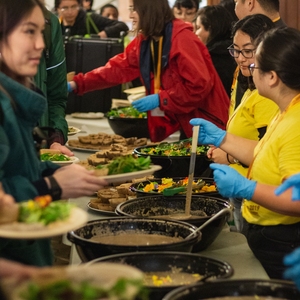Students of Color Environmental Conference
University of California, Berkeley
Project Overview
The first ever Students of Color Environmental Conference (SCECon) was intended to bring together students of color from across California to connect and build with local environmental justice activists. This year’s theme was ‘Root, Sprout, Blossom’, chosen to reflect our intention to explore our collective hxstories, learn new skills, and imagine a more just and sustainable future for all. The event included an opening and closing keynote, delivered by Theresa Baker of The African American Nature and Parks Experience and Vincent Medina of mak-'amham Contemporary Ohlone Cuisine. Nineteen workshops split between two workshop blocks allowed attendees to delve into specific topics ranging from zero-waste to urban planning to backpacking. Identity caucuses facilitated by attendees created intimate discussions centered around race, ability, citizenship, sexuality and gender identity and the intersection of these identities with climate justice. A panel of four environmental educators and activists discussed tools climate organizing, resiliency and collaboration. The conference was completely free of cost so attendance was not hindered by the ability to pay for transportation, housing, and food.The conference used Slack to communicates logistics to attendees before the day on the conference, provide live updates, and allowed attendees to connect even after the event.
Background
The Students of Color Environmental Collective (SCEC) came into existence in 2015 when several students of color felt alienated in the environmental community, but knew their voices were needed in the movement to further social and environmental justice. Environmentalism tends to be an inaccessible space for people of color due to a multitude of complex reasons, and our campus, UC Berkeley, is no exception. Historically, environmental racism impacts even our own College of Natural Resources at an institutional level, where we educate and shape the the next generation of climate leaders at a top-ranked environmental program. Here, 80% of CNR faculty are white. Therefore, this project aims to empower and inspire underserved and underrepresented communities to reclaim their spaces in the environmental movement, learn about environmental justice, and reconnect with the outdoors.The conference was financed by The Green Initiative Fund at UC berkeley, a grant program that finances student-led environmental projects. The Students of Color Environmental Collective was awarded this grant in May 2018. A six person conference planning team worked from September 2018 until the day of the conference on February 2nd, 2019. The conference provided a dynamic learning experience for students to attend workshops, keynote addresses, panels and identity caucus discussions. This conference was intended to be as barrier-free as possible to allow historically underrepresented students of color to attend without the burden of paying for attendance, food, merchandise, travel and housing accomodations. Workshops allowed students researchers and activists to showcase their work for their peers. Three communal meals were provided to all attendees and allowed for community building and networking in an informal setting. This conference connected students and community members of color from different universities and states with one another and established a vibrant community centered around environmental justice and social change.
Goals
The Students of Color Environmental Conference was a bigger action of the Students of Color Environmental Collective in their vision to create a more inclusive and diverse College of Natural Resources at UC Berkeley in their #EnvironmentalismSoWhite campaign. This conference’s success and eager reception proves to show how relevant, how necessary, and how important this is to the environmental justice movement. Environmental spaces have historically been white dominated spaces that are exclusionary for folks of color. Our goal for this conference was to create a safe space for students and community members of color could discuss their experiences with environmental justice without the worry of being silenced or tokenized due to their racial or ethnic identities. The Students of Color Environmental Conference succeeded in showing the importance of environmental spaces and conferences created by students of color as a refuge from white dominated environmentalism. Numerous conference attendees had a positive experiences and appreciated the safe space to engage with other students of color. These spaces are integral in the environmental education for students of color and are import to preserving cultural legacies and histories within the environmental movement. We hopes to create space for students of color to foster dialogue about collective environmental actions, solidarity between different identities and unification of various groups working towards environmental justice. Many in academia often believe that safe spaces for only students of color are unnecessary or too difficult to create, but this conference demonstrates the need for such spaces and the ability for students to organize to create them. This student led effort demonstrates the need to educational institutions to create environmental programs for students of color and implement educational resources outside of the white dominated environmental narrative.
Implementation
The Students of Color Environmental Conference was financed by The Green Initiative Fund, UC Berkeley’s campus green fund. The conference also partnered with The Student Environmental Resource Center as our advisor in the conference planning process. The conference collaborated with student organizations both at UC Berkeley and at other colleges across California to recruit conference attendees. Social media posts, graphics, email listserv announcements and newsletters were widely circulated across the country to draw attendees from Southern California to Pennsylvania. Some attendees represented their universities and communities in leading workshops about their research and activism. Keynote speakers and panelists represented local organizations and groups such as the UC Berkeley Graduate Assembly, Communities for a Better Environment, Bay Area Environmental Educators of Color and The African American Nature and Parks Experience. Local vendors including Acme Bread, Saturn Cafe and La Mediterranee generously donated breakfast and snack items. Organizations including ChangeScale and Ecology Center tabled during the conference luncheon. These various collaborations helped to finance the conference and make it barrier-free for all attendees, build partnerships with different student organizations across the state and country, and allow representatives from various local organizations to share their stories with conference attendees.
Timeline
Project Timeline Link: https://docs.google.com/document/d/1auy-klfSznHjxUJyDf1fFEpdyPM55eCJz1R99OfRFi4/edit?usp=sharing
Financing
The Students of Color Environmental Conference was awarded a $25,050 grant from The Green Initiative Fund. The grant was used to pay keynote and panelist speakers, reserve classrooms and auditoriums at UC Berkeley for the day of the conference, cater two meals from local cultural vendors, created merchandise( stickers, lanyards, t-shirts) and pay the six members of the planning team for their labor.
A detailed link to our finance sheet: https://docs.google.com/document/d/1IvLL9BC-FcM4oAa-GxbBf1IZia1O1JNM16HlWhnYWwI/edit?usp=sharing
Results
We administered a feedback survey for conference attendees to give us their evaluations and reflections about the conference. Of those who filled out the form, most of the responses said that the conference reflected a diversity that they were seeking for in the environmental movement. Here are quotes from satisfied attendees: “I left the conference feeling inspired to take action about issues that I see in my community and to feel like I have a place in the environmental movement. All of my experiences in environmental justice and conservation work have been dominated by white people, so learning from people who are doing the work I'm passionate about that also look like me and share my concerns about POC communities was truly amazing.” “As a community college student, I have newfound confidence in my ability to make it in higher education. It helps to know there is a community of students of color active in the environmental movement in and out of the academia bubble. It was heartwarming to see that all of the people I met the day of the conference from volunteers, organizers and speakers were happy to converse and connect.” The conference concluded on February 2nd, 2019 after the one day event. In the following months, the conference planning team created a final project report and poster for The Green Initiative Fund to present how the funds were used for the advancement of environmental education for students of color. The conference has been renewed for another year at UC Berkeley or at another university campus, with $28,000 secured for 2019-2020 academic year!
Lessons Learned
This event inspired many attendees to push to create similar events on their campuses. As many universities now have grant funding for student initiated projects, it is feasible for students at other universities to recreate this conference or other large scale environmental justice and education events for students of color. After the conference, our planning team was approached by students from UCLA and UCSB to continue this conference on their campuses.


